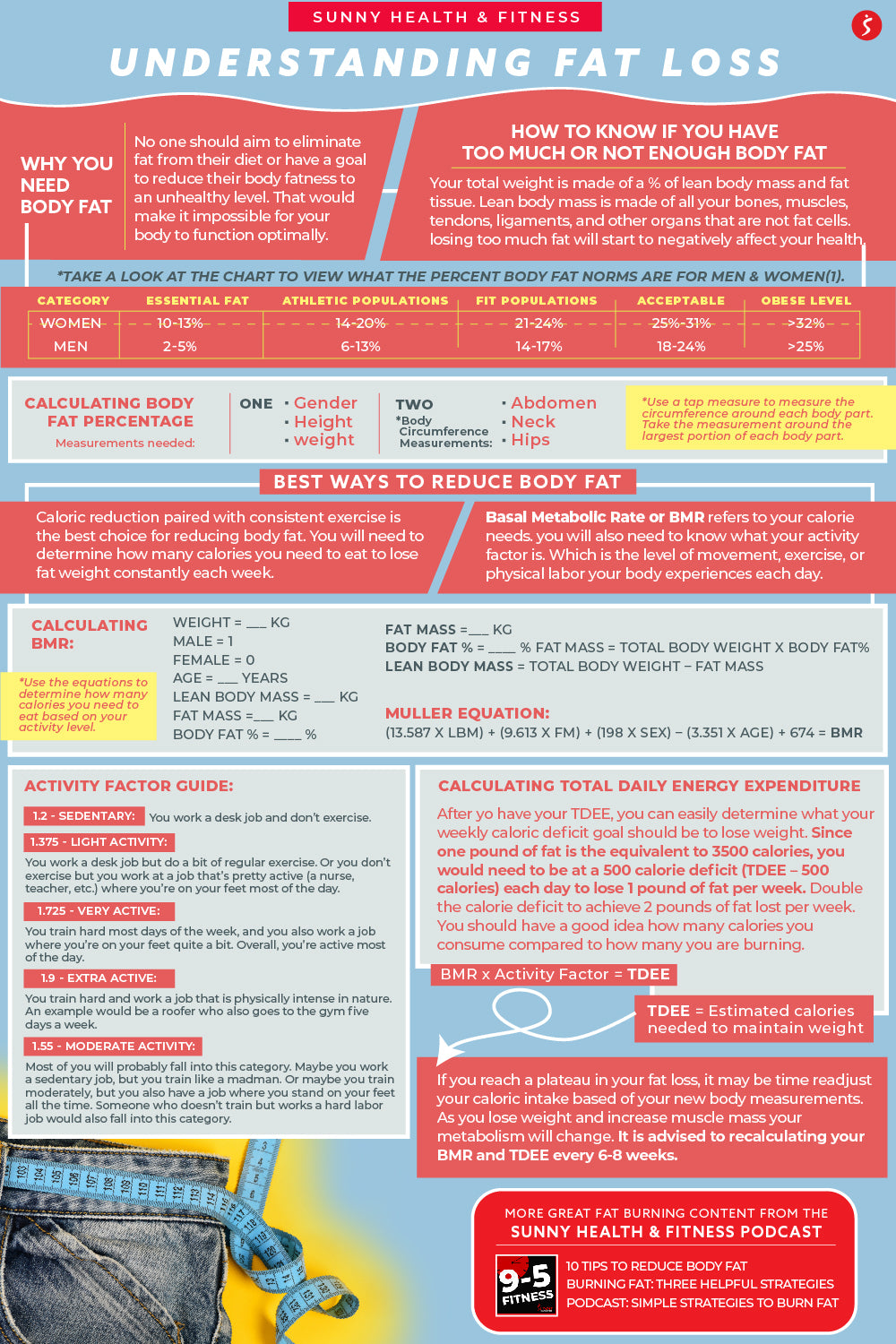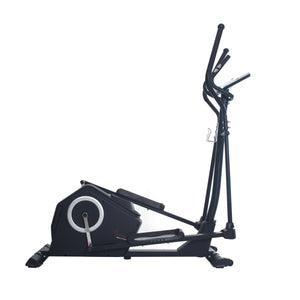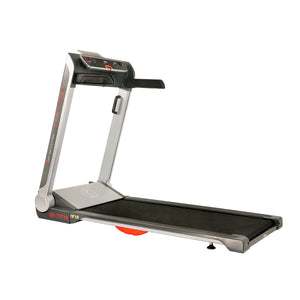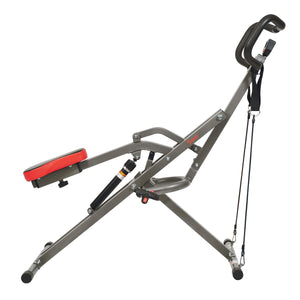Why You Need Body Fat
Contrary to its negative connotation, “fat” is essential for good health. Body fat is a major role player in a variety of different functions and structures within your body. Fat cells can act as fuel storage for the body and aid in a variety of important hormone functions. Fat also helps with the absorption of certain vitamins and plays an important role in temperature regulation. Your brain function, bone health, nerve function, and cell membranes can all be affected in a negative way if fat consumption reaches a dangerously low level. Basically, without adequate amounts of fat, it would be impossible for your body to function optimally. This is why no one should aim to eliminate fat completely from their diet or have a goal to reduce their body fatness to an unhealthy level.
How to Know If You Have Too Much Or Not Enough Body Fat
Simply checking the scale or gazing in the mirror won’t give you enough info to determine your true body fat amounts. While your total weight will be a factor in determining your body fat measurement, it’s important to remember that your total weight is made of a percentage of lean body mass and fat tissue. Lean body mass is made of all your bones, muscles, tendons, ligaments, and other organs that are not fat cells. Reducing the health and amount of the body’s lean mass is not advised. While reducing the body’s amount of fat tissue is necessary for a lean physique, losing too much fat will start to negatively affect your health. This is where body fat measurements come into play. Knowing how to accurately measure your body fat will help you determine if you need to work on lowering or increasing the amount of fat tissue in your body. Take a look at the chart below to view what the percent body fat norms are for men and women(1).
| Category | Women | Men |
| Essential Fat | 10-13% | 2-5% |
| Athletic Populations | 14-20% | 6-13% |
| Fit Populations | 21-24% | 14-17% |
| Acceptable | 25%-31% | 18-24% |
| Obese level | >32% | >25% |
Calculating Body Fat Percentage
Getting a good estimate of your current body fat percentage will require gathering of a few different body measurements. After you gather the appropriate information, you can plug the info into a body fat percentage calculator to see where you fall on the chart above. This will tell you if your overall body fat is something you should focus on reducing or increasing. Below is a list of measurements you should have.
1) Gender, height, weight
2) Body Circumference Measurements
- Abdomen
- Neck
- Hips
*Use a tap measure to measure the circumference around each body part. Take the measurement around the largest portion of each body part.
After you have these measurements, head over to the body fat calculator here(2).
Best Ways to Reduce Body Fat
Caloric reduction paired with consistent exercise is the best choice for reducing body fat. This means you will need to determine how many calories you need to eat to lose fat weight constantly each week. Use the equation below to determine how many calories you need to eat based on your activity level. When talking about caloric needs, I am referring to your Basal Metabolic Rate or BMR. In the equation below, you will also need to determine what your activity factor is. Your activity factor is the level of movement, exercise, or physical labor your body experiences each day. Read the descriptions of each activity factor and determine which measurement best fits your lifestyle.
Calculating BMR (Basal Metabolic Rate):
Weight = ___ kg
Male = 1
Female = 0
Age = ___ years
Lean Body Mass = ___ kg Fat Mass =___ kg Body Fat % = ____ %
Fat Mass =___ kg
Body Fat % = ____ % Fat Mass = Total Body Weight x body fat%
Lean Body Mass = Total Body Weight – Fat Mass
Muller Equation (13.587 x LBM) + (9.613 x FM) + (198 x Sex) – (3.351 x Age) + 674 = BMR
Activity Factor Guide
1.2 - Sedentary: You work a desk job and don’t exercise
1.375 - Light Activity: You work a desk job but do a bit of regular exercise. Or you don’t exercise but you work at a job that’s pretty active (a nurse, teacher, etc.) where you’re on your feet most of the day.
1.55 - Moderate Activity: Most of you will probably fall into this category. Maybe you work a sedentary job, but you train like a madman. Or maybe you train moderately, but you also have a job where you stand on your feet all the time. Someone who doesn’t train but works a hard labor job would also fall into this category.
1.725 - Very Active: You train hard most days of the week, and you also work a job where you’re on your feet quite a bit. Overall, you’re active most of the day.
1.9 - Extra Active: You train hard and work a job that is physically intense in nature. An example would be a roofer who also goes to the gym five days a week.
Calculating Total Daily Energy Expenditure
Now we take the BMR you just calculated and multiply it by the corresponding number that represents you within the Activity Factor Guide
BMR x Activity Factor = TDEE
TDEE = Estimated calories needed to maintain weight
After you have your TDEE, you can easily determine what your weekly caloric deficit goal should be to lose weight. Since one pound of fat is the equivalent to 3500 calories, you would need to be at a 500 calorie deficit (TDEE – 500 calories) each day to lose 1 pound of fat per week. Double the calorie deficit to achieve 2 pounds of fat lost per week. Whether you choose to consume less calories or burn more calories through increased activity, you should have a good idea how many calories you consume compared to how many you are burning. For example, if you burn 250 calories doing cardio, you would only need to decrease your calorie consumption by 250 calories to reach your 500 calorie deficit goal for that day. If you reach a plateau in your fat loss, it may be time readjust your caloric intake based of your new body measurements. As you lose weight and increase muscle mass your metabolism will change. For these reasons, I would advise recalculating your BMR and TDEE every 6-8 weeks.
Take Home Points
- Calculate your current body fat percentage
- Determine if you need to lose or gain body fat
- Set a long-term goal of 1
- 2% body fat lost or gained each month
- Focus on both diet and exercise to maximize results - Focus on long term consistency
More great fat burning content!
10 Tips to Reduce Body Fat
Burning Fat: Three Helpful Strategies
Podcast: Simple Strategies to Burn Fat
(1) “Percent Body Fat Calculator: Skinfold Method”. ACE Fitness, n.a., https://www.acefitness.org/education-and-resources/lifestyle/tools-calculators/percent-body-fat-calculator/. Accessed 21 August. 2020.
(2)“Body Fat Calculator”. LIVESTRONG, n.a., https://www.livestrong.com/tools/body-fat-calculator/. Accessed 21 August. 2020.

























Add Your Name & Email
Please enter your name and email to continue.We won’t display your email publicly.